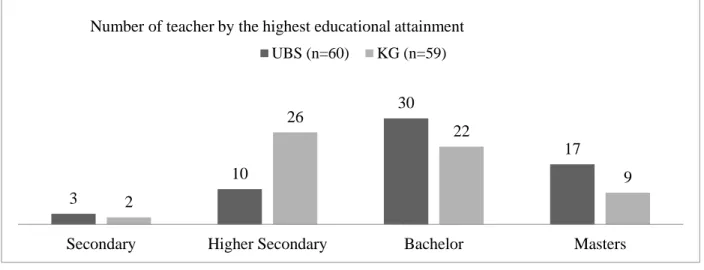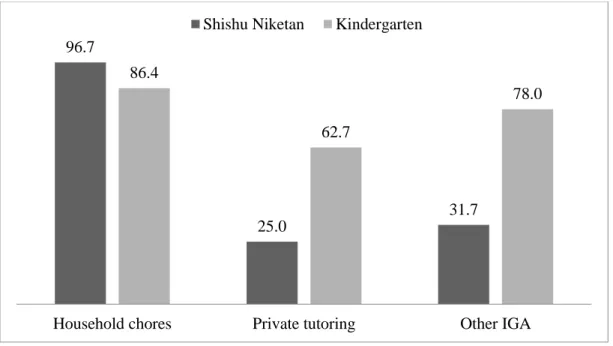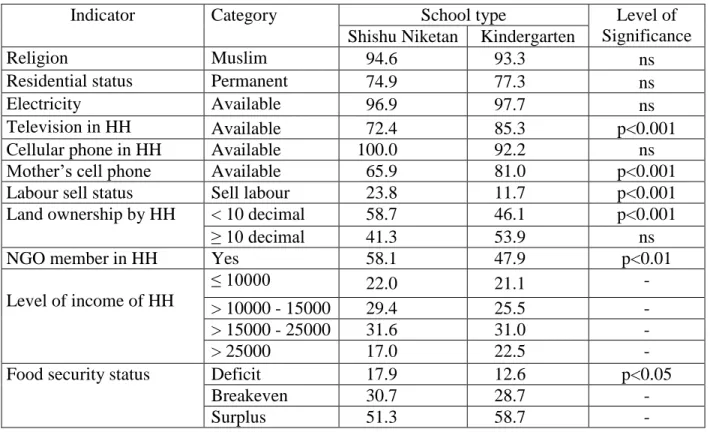The socioeconomic background of kindergarten students was comparatively better than the Shishu Niketan schools in terms of household income and wealth and parental education. While two-thirds of students in kindergartens used private tutoring, it was 13.3% among students in Shishu Niketan schools. The educational qualifications of the teachers at the Shishu Niketan schools were more than those of the kindergartens.
Most of the assistant teachers of Shishu Niketan schools had a Bachelor's degree and the principals had a Master's degree. All Shishu Niketan school teachers had basic teacher training, which was not the case with kindergarten teachers. The objective of this evaluation is to assess the impact of Shishu Niketan schools on the level of results and outcomes.
The purpose of this baseline study was to explore the status of the Shishu Niketan schools compared to the kindergartens in the same locality during the initial period of the project. What is the socio-economic background of teachers and students in Shishu Niketan and kindergartens during the initial period of the project.
Research Design
Data Collection Instrument
THE SHISHU NIKETAN SCHOOLS AND KINDERGARTENS
School Profile
Floors and walls of the Shishu Niketan schools were made of brick and the roofs of tin-lined corrugated iron. The provision of water filters was observed in twelve Shishu Niketan schools, compared to three kindergartens. BEP has plans to establish a parent committee and a school management committee (SMC) in each of the Shishu Niketan.
The Shishu Niketan teachers were asked about school monitoring by the Program Organizers (PO) and the Area Managers (AM). The Shishu Niketan schools started in January 2017 with 325 students in pre-primary education, 220 students in class I and 146 students in class II (Table 3). The monthly variation in the proportion of girls was greater in Shishu Niketan schools than in kindergartens.
At Shishu Niketan schools, the proportion of girls in pre-primary and first grade was over 46%, and in second grade it was 51.9%. Therefore, the percentages in kindergartens were much lower than those in Shishu Niketan schools. On average, three-quarters of Shishu Niketan students attended the counting day, which was 75.9% among kindergarten students.
The attendance rate was 83.5% for Shishu Niketan students and 85.1% for kindergarten students. Although the rates were similar for kindergarten boys and girls, a slight difference was observed in favor of boys in Shishu Niketan schools. The average contact time in Shishu Niketan schools was 3.2 hours for pre-primary, four hours for first grade and 4.2 hours for second grade.
Multimedia classrooms and the use of digital content were some of the unique features of Shishu Niketan schools.

Teacher profile
The use of multimedia and digital content was investigated in 12 preschool, 13 first grade classrooms and 10 second grade classrooms. class in Shishu Niketans. On average, 16 hours of preschool and first grade and 15 hours of second grade were conducted using multimedia based on teacher self-reported data on activities over the past three months. Among female educators, 3.4% had a secondary or lower education, 44% had a high school diploma, 37.3% had a bachelor's degree, and 15.3% had a master's degree.
The above figures clearly show that the teachers of Shishu Niketan s were far ahead of their counterparts in the kindergartens in terms of educational qualifications. While two teachers of the kindergartens were educated from the madrasas; no such teachers were observed in the Shishu Niketan School. BRAC has a provision for basic training for 11 days for all its teachers which is not the case for the kindergartens.
Most of the teachers at Shishu Niketan schools (98.3%) received basic training before joining their current schools; among kindergarten teachers this was 6.8%. A quarter of the teachers at Shishu Niketan School also received training from other sources before joining their current school; among kindergarten teachers this was 13.6%. Overall, all teachers from Shishu Niketan schools and 18.6% of those from kindergartens had completed training.
In addition to teaching, teachers of both types of schools were observed to be involved in housework and other income-generating activities (IGA). For example, 96.7% of Shishu Niketan and 86.7% of kindergarten teachers were involved in housework. A quarter of Shishu Niketan school teachers and 62.7% of kindergarten teachers engaged in private tutoring for extra income.
The involvement of teachers in other income generating activities (IGA) in the case of kindergartens was as high as 78%.

STUDENTS’ HOUSEHOLD PROFILE
- Socioeconomic characteristics of households
- Educational attainment of parents
- Age distribution of students
- Previous educational experience of students
- Reasons behind choosing present school
- Tutoring support for the students
- Expenditure for education
Information on years of schooling completed by both parents of the students from two types of schools was collected. A quarter of the fathers and 15.2% of the mothers of Shishu Niketan students have never been to school. These figures were 10.9% among the fathers and 6.4% among the mothers of the students of kindergartens (Table 10).
The mothers of 13.5% of Shishu Niketan school students have not completed primary education, 52.5% have completed primary but not secondary education and 18.8% have completed secondary education. The educational qualifications of both parents of the kindergarten students were ahead of those of the parents of the Shishu Niketan students. The literacy rate of parents of kindergarten students was significantly higher than that of Shishu Niketan schools (p<0.001).
On average, both parents of more than three-quarters of kindergarten students were literate. The average age of Shishu Niketan's students was 4.7 years for pre-primary education, 6.6 years for grade I, and eight years for grade II. While two-thirds of first and second grade Shishu Niketan students had preschool education experience, this was 98.6% among first graders and 90.9% among second graders of kindergartens (Table 14).
Proportionally more boys than girls in the first grades of Shishu Niketan schools had pre-primary education (70% versus 61.5%). Almost one-fifth of the first-grade students and 73.7% of the second-grade students of Shishu Niketan schools had previous experience of studying at the primary level (Table 15). Over two-thirds of kindergarten students and 13.5% of those from Shishu Niketan schools used private tutoring to supplement their school education (p<0.001).
Almost 15% of students in Shishu Niketan schools and less than 10% of kindergarten students had none of these supports. A statistically significant difference between the types of schools can be observed in the expenditure of pupils of each class (p<0.001). Therefore, total expenditure was significantly higher for kindergarten students than those in Shishu Niketan schools.

FROM TRAINING TO CLASSROOM: TEACHERS’ PERSPECTIVES
- Training Duration and Content
- Learning from Training
- Delivery Method of Training
- Difficulties in Training
As one of them mentioned, 'The English part of the training was completely in English, and we were also required to speak English with each other. While talking about various aspects of the training, one teacher appreciated the lesson delivery method. Explains the fact that the facilitator of the training was really patient and available; she commented that 'it was an effective'.
One teacher said with satisfaction that the training helped her to get rid of her nervousness and that there was hardly anything she didn't like. Another teacher found that step-by-step math problem solving was really effective for her classroom, saying, “My students seem really happy when I do step-by-step math problem solving while teaching in the classrooms. Similarly, another teacher stated that discussing creative questioning, story telling, extracurricular activities, steps in solving mathematical problems, etc.
Similarly, another teacher identified how learning from training helped her teach English classes and she pointed out. The training on English speaking therefore helped me to teach in the class especially for grade I. The most useful learning from the training was the application of teaching materials for Mathematics lessons.
Likewise, another teacher said that the digital content helped them a lot in teaching Bangla alphabets and words and their correct pronunciation. A school principal shared the need for a longer session for the leadership and management part of the training. Summarizing the discussion of this chapter, it can be inferred that the teachers of Shishu Niketan schools showed a satisfactory perception of the training they received.
They also showed their enthusiasm for using the knowledge and skills they acquired during the training.
DISCUSSION AND RECOMMENDATIONS
Discussion Schools
To ensure effective management of the school activities, the provision of parent committee and school management committee was also observed in Shishu Niketan schools. The arrangement of the multimedia classroom was there in all the Shishu Niketan schools and they already started conducting classes using multimedia. However, in terms of teaching experience, the kindergarten teachers were more experienced than those in the Shishu Niketan schools.
On the other hand, Shishu Niketan teachers were exposed to more training than their counterparts. All the teachers of Shishu Niketan schools were women, but half of the principals and a large proportion of the assistant teachers of kindergartens belonged to that category. The monthly salary of Shishu Niketan teachers was relatively higher than that of kindergarten teachers.
Almost three-quarters of the students at the Shishu Niketan schools were permanent residents of the special areas. Although not much variation was observed in monthly household income in two groups of students, proportionally more students from Shishu Niketan schools came from food security deficit households. The kindergarten students were also far ahead of those in the Shishu Niketan schools in this regard.
A perfect age-grade match was also more common in Shishu Niketan schools than in kindergartens. While reporting the reasons for choosing Shishu Niketan schools for their children, the majority of parents mentioned “quality of education.” Therefore, it is important to maintain the quality of Shishu Niketan schools throughout the implementation years.
This shows the fact that BRAC has introduced a low-cost alternative to education in the respective areas through the introduction of Shishu Niketan schools.







